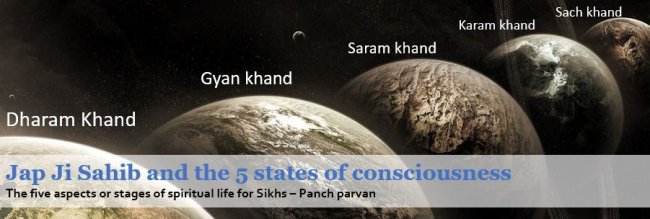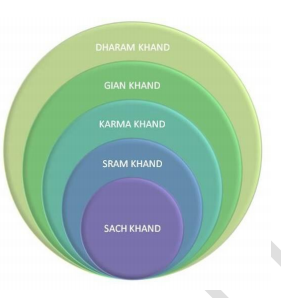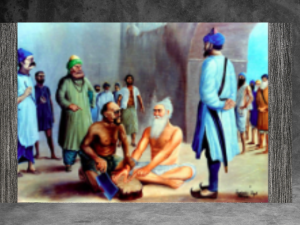Guru Nanak recognized and accepted that religious(1) and spiritual quest was a matter, which was altogether internal to man. It is not a matter of external practices and observances of traditional forms and prescriptions of religion. Rather it is a matter, firstly, of cleaning and purifying one's mind, secondly filling it with intense love and devotion to God, and waiting cravingly for its grace (kirpa, prasad, bakhsis, daia, bhana, karam etc.), and thirdly seeking unceasingly a complete blending of oneself with the universal self (God). Guru Nanak proclaims:
ਆਤਮਾ ਪਰਾਤਮਾ ਏਕੋ ਕਰੈ ॥ ਅੰਤਰ ਕੀ ਦੁਬਧਾ ਅੰਤਰ ਮਰੈ ॥
His soul and the Supreme Soul become one. The duality of the mind is overcome. (Mehl 1, SGGS, p 661)
Guru Nanak enunciated that for the final merger with universal self, each individual aspirant must prepare oneself by going through five domains (Panj khads) on the path of truthful living. An analysis of these domains indicates that Guru Nanak was aiming at the transformation of the individual psyche and will by bending and directing both towards the ultimate goal of achieving the status of sachiara (truthful being) and thereby one's merger with the Ultimate Absolute. Guru Nanak proclaimed this the last reach of human experience is Panch Parvan. In stanza 26 of Jap composition, Guru Nanak describes the status of Panch Parvan as;
ਪੰਚ ਪਰਵਾਣ ਪੰਚ ਪਰਧਾਨੁ ॥ ਪੰਚੇ ਪਾਵਹਿ ਦਰਗਹਿ ਮਾਨੁ ॥ ਪੰਚੇ ਸੋਹਹਿ ਦਰਿ ਰਾਜਾਨੁ ॥ ਪੰਚਾ ਕਾ ਗੁਰੁ ਏਕੁ ਧਿਆਨੁ ॥
The chosen ones, the self-elect, are accepted and approved. The chosen ones are honored in the Court of the Lord. The chosen ones look beautiful in the courts of kings. The chosen ones meditate single-mindedly on the Guru. (Mehl 1, SGGS, p 4)
To understand the meaning of the term Panch Parvan, let us see what the Sikh theologians say about it. Prof. Teja Singh, a noted Sikh theologian, describes(2) that the term Panch Parvan convey the idea that such human beings are the best representatives of the people, raised above the crowd, not because God has appointed them as His representatives, His elect, but because they have worked themselves up with the same material and the same chances as other people around them, and have acquired commanding personalities (by attaining spiritual, moral and social leadership). They are not avatars working as men; for then, their ideals would be beyond our capabilities. They are, rather, men of the world, working themselves into God-like beings, and serving as practical examples to the rest of mankind. They are true Jivan Muktas (Self realized persons).
In Sikhism, the term, Jivan Mukta denotes(3) a person, who has attained liberation from human bondage of egoism, ignorance, passion, avarice, pride and infatuation. Such a person has attained to the highest spiritual state of being in tune with the Ultimate Reality, while still living. He or she is the one who has realized the essence of human life. Guru Nanak's depiction of Panj Khands (Five Domains) describes a pathway to Ultimate Reality, a journey from being to becoming a Jivan Mukta or Panch Parvan.
The Sikh worldview holds that Ultimate Reality, in its own volition, has created both: the state of bondage and the state of freedom.
ਮੁਕਤ ਬੰਧ ਸਭਿ ਤੁਝ ਤੇ ਹੋਏ...॥
The free and the bonded alike are your creation. (Mehl 3, SGGS, p 796)
A noted Sikh theologian, J. S. Neki reports(4) that, "In point of fact, man is born free, but as he grows up, the ways of the world grow upon him. That is how from his nascent free state (equanimity or sahaj) he slinks down step by step into the conditioned existence of worldly pursuits. In order to re-emerge from it and to re-attain the original state of equanimity he must pursue the path of devotion. Liberation (mukti), in fact, is a by-product of the practice of devotion, not its highest objective, which is nothing short of God-experience itself, and subsequently remaining immersed in it forever". Guru Nanak's elaboration on Panj Khands in his Jap composition, is a manual for pursuance of truthful living to become sachiara, who reaches the ultimate stages of Jivan Mukta, and Panch Parvan.
Panj Khands (Five Domains)
Panj Khands, literally: panj = five, khand = domain or realm. Panj Khands signify the five phases of progression on the path of Truthful Living, leading a devotee to the realization of Ultimate Reality. These Khands are enumerated in Stanzas 34 to 37 of Jap hymns(5-10) as;
- Dharamkhand (Domain of Righteousness), Stanza 34.
- Giankhand (Domain of Knowledge), Stanza 35.
- Saramkhand (Domain of Endeavour), Stanza 36.
- Karam khand (Domain of Grace), Stanza 37.
- Sach Khand (Domain of Truth), Stanza 37.
The concept of the such a journey11 running into several phases is found in many other religious traditions as well. The number of phases and the nomenclature do vary, but the broad features of the journey remain the same. The seven muqamat of the Sufis, the eight angas of Patanjal yoga, the five kosas of Vedanta and dashbhumis of Buddhism run on parallel lines though each of these are embedded in a different cultural milieu.
In stanza 32nd of Jap hymns, Guru Nanak describes the term pavarian (rungs of a ladder), denoting phases of progression on the path of Truthful Living. Guru Nanak proclaims that this progression is achieved by continuous contemplation of Ultimate Reality. Thereafter, the insight occurs that all the endeavours of the devotee have their ultimate source in divine grace.
In PanjKhands stanzas of Jap verses of Guru Nanak delineate the different phases of progression of a devotee, on the path of Truthful living, tracing the evolution of his thought, emotions and action in each phase. In stanzas 34-37, Guru Nanak touches upon the core characteristics of each domain. In each domain, the status of the individual is set forth in a social setting(10-11). The devotee is not conceived of as a recluse or ascetic. The social obligations and moral qualities of the devotee form an essential core of this path.
As described by Guru Nanak, on this pathway, the empirical mind is first emancipated from the grip of worldly desires and entanglements, and is purified by a rigorous moral discipline. When it attains a state of mental and spiritual equipoise (sahaj), without the least intrusion of ego, it is brought to the divine portal, which it can enter only with the divine grace. There it finds itself face to face with the Ultimate Reality i.e. the Truth Eternal.
Now, let us have a look at a brief description of each domain as enumerated by Guru Nanak in his Jap hymns.
Dharam Khand (Domain of Righteousness)
The devotee's first phase on the path of Truthful living, occurs in dharamkhand (Domain of Righteousness). Guru Nanak proclaims that the world exists for righteousness to be practised.
ਧਰਮੁ ਕਰਾਏ ਕਰਮ ਧੁਰਹੁ ਫੁਰਮਾਇਆ ॥
It is ordained (by the creator) that mortals must practice righteousness. (Mehl 1, SGGS, p 1280)
The word righteousness symbolizes duty, which is generally performed either out of a sense of social responsibility or through moral awareness. Guru Nanak links this sense of duty to man’s consciousness of natural justice. In this phase a sense of inquisitiveness is evoked in the devotee's mind. Thereby he, now, no longer remains a casual onlooker of the surrounding world. He becomes capable to perceive the Creator's purpose imbedded in the creation of our planet, the earth, which is set in the cosmic cradle of time and space and is sustained by the vital elements. Human beings have been placed in this world to respond to the Creator’s purpose. As per the Cosmic Law and order, ordained by the Creator, the devotee will be endorsed, according to his moral response. Righteous living requires full participation in worldly affairs subject to universal moral principles, with emphasis on good thoughtful action and love of God, whilst living in this multi-people, multi–faith and multi-coloured earth. The righteous living inspires the individual seeker to the next stage of Gian Khand.
Gian Khand (Domain of Knowledge)
The devotee reaches the second phase of his progression on the path of Truthful living, in giankhand (Domain of Knowledge). In this domain, the devotee becomes aware of the universe and the mystery of its existence. Through the creation, he gains knowledge of the Creator from whom it emerges. In this phase, the devotee becomes aware that there is not just one Brahma, one Vishnu, one Shiva, (Trinity of Gods in Hinduism) but they are countless indeed. In fact, the Creator has created numerous suns, moons, gods, demons, planets, solar systems, multiverse, kings, and emperors. The devotee with this wondrous knowledge added to his righteous living transcends into the next stage of Saram Khand. Guru Nanak proclaims;
ਬਿਦਿਆ ਸੋਧੈ ਤਤੁ ਲਹੈ ਰਾਮ ਨਾਮ ਲਿਵ ਲਾਇ ॥
Considering his knowledge, he finds the essence of reality, and lovingly contemplate on the Creator. (Mehl 1, SGGS, p 938)
Dr. Ram Singh(11), a noted Sikh theologian, elaborates that knowledge here is not merely intellectual or sensual, but is an intuitive awareness or spiritual consciousness which expands the vision of the devotee. The devotee's sense of wonder is born not merely of his awareness of the many forms of life or the ordered movement of numerous celestial bodies, but of his perception of Ultimate Reality, who is the sole creative force behind all. In front of this limitless variety of cosmic life, he feels humble. This simultaneous experience of expansion of vision and of the sense of humility leads to vismad (wonder). Stressing upon the need of acquiring knowledge to understand and appreciate the world around us, an eminent Christian theologian Ralph W. Sockman proclaims12; “The larger the island of knowledge, the longer the shoreline of wonder.”
SaramKhand (Domain of Endeavour)
In the third phase, the devotee finds himself in SaramKhand (Domain of Endeavour). Here the devotee strives against the last remnants of his ego, which still afflict him in spite of his experiencing strong emotions of humility in the Domain of Knowledge. If the sense of awe and wonder is not accompanied or followed by discipline, the experience might become a mere emotion, something remembered with nostalgia but having no permanent worth. To become worthy of receiving the divine grace, one must chisel one’s consciousness (surati), which is a unifying thread for all human faculties. This chiselling of intellect and wisdom would erase even the subtlest layers of ego from one’s mind. To do so, Guru Arjan Dev encourages the devotee to put in his best efforts to lead a truthful life by following the Guru's teachings (gurmat).
ਉਆ ਡੇਰਾ ਕਾ ਸੰਜਮੋ ਗੁਰ ਕੈ ਸਬਦਿ ਪਛਾਨੁ ॥ ਇਆ ਡੇਰਾ ਕਉ ਸ੍ਰਮੁ ਕਰਿ ਘਾਲੈ ॥
You shall come to realize the way to that place (Ultimate Reality), through the Guru's teachings (sabd, gurmat). This place (the world), here, is established to do hard work (endeavour). (Mehl 5, SGGS, p 256)
Thus being engaged in spiritual endeavour, devotee begins to feel a touch of spiritual joy and his mind is chiselled into a unique mould. In this phase, his intellect, understanding, wisdom, and consciousness undergo a typical transformation, leading him on to the next stage of Karam Khand.
Karam Khand (Domain of Grace)
A devotee's fourth phase on the path of Truthful living falls in Karam Khand (Domain of Grace). The process of liberation with grace, gets initiated and is brought to completion in this phase. All sense of dualism ends. The devotee reaches a state where he is one with Ultimate Reality and with those who have attained this state of bliss. A devotee reaches here only after achieving a heroic victory over the evils. Yet he is not a passive devotee, but a man of awakened courage and great deeds. Guru Nanak describes that such a devotee, whose mind is brimming with truthfulness, is blessed with ultimate glance of grace by the Creator. Guru Nanak Dev proclaims;
ਇਹੁ ਮਨੁ ਸਾਚਿ ਸੰਤੋਖਿਆ ਨਦਰਿ ਕਰੇ ਤਿਸੁ ਮਾਹਿ ॥
One whose mind is contented with Truthfulness, is blessed with the Creator's Glance of Grace. (Mehl 1, SGGS, p 19)
Sach Khand (Domain of Truth)
The final phase on the path of Truthful living happens in sach khand (Domain of Truth). Guru Nanak describes that the Ultimate Reality resides in the Domain of Truth, which defies description. Although the Domain of Truth, has been described as the abode of the Ultimate Reality, yet it is not a geographical spot, but the final state of the evolution of human consciousness. One can only experience it, but not describe it. In this phase, words cease to have any meaning and no analogies can help in describing the Unique. Here in communion with Ultimate Reality (God), the perfect ones rejoice in its presence. As a tiny drop of water falling into the ocean, becomes part of it, so does the devotee, in this phase, merge completely with the Truth Eternal.
ਸਚੁ ਮਿਲੈ ਸਚੁ ਊਪਜੈ ਸਚ ਮਹਿ ਸਾਚਿ ਸਮਾਇ ॥
Meeting the True One, Truth wells up. The truthful are absorbed into the True One. (Mehl 1, SGGS, p 18)
It is from here that God's Command (hukam) goes out to the universe, and the liberated, grace-filled souls perform it joyously and effortlessly. The devotee merges with Ultimate Reality and realizes it as a unifying creative force working through all objects of its creation. This way the devotee attains the non-spatial Domain of Truth and the dweller therein, the Ultimate Reality. In his Jap hymns, Guru Nanak Dev describe the status of such a spiritually enlightened devotee, as Panch Parvan;
ਸਚਾ ਆਪਿ ਸਚਾ ਦਰਬਾਰੁ ॥ ਤਿਥੈ ਸੋਹਨਿ ਪੰਚ ਪਰਵਾਣੁ ॥
He Himself is True, and True is His Court. There, in perfect grace and ease, sit the self-elect, the self-realized Saints. (Mehl 1, SGGS, p 7)
Culmination
As a culmination to his Truthful living, a devotee attains two notable rewards. Firstly, he gains the realization of the Ultimate Reality, a real enlightenment. Guru Nanak Dev asserts;
ਸਾਚੈ ਸਾਚੇ ਸਾਚਿ ਸਮਾਵਹਿ ॥
Through Truth, the truthful ones merge into the True One. (Mehl 1, SGGS, p 839)
Such a devotee is not just free from this or that, he is the master of sense and self, fearless and devoid of rancour, upright yet humble, treating all creatures as if they were he himself, wanting nothing, clinging to nothing. He rises from the life of do’s and don’ts to that of perfection—a state of oneness with all. Guru Amar Das elaborates on such a state as;
ਪਰਪੰਚੁ ਚੂਕੈ ਸਚਿ ਸਮਾਇ ॥
Then, the illusion of the material world is shattered, and one merges in Truth. (Mehl 3, SGGS, p 842)
Secondly, the devotee is not just a friend for all, he even strives for their freedom as well. He no longer lives for himself. He lives for others. Guru Arjan Dev in his Sukhmani hymns describe that such a devotee attains the supreme status of Brahm Giani (God-conscious being).
ਬ੍ਰਹਮ ਗਿਆਨੀ ਪਰਉਪਕਾਰ ਉਮਾਹਾ ॥
The God-conscious being delights in doing good to others. (Mehl 5, SGGS, p 273)
The ideal state of jivan-mukta or Panch Parvan is, notionally, within the reach of every human being, since anyone leading a Truthful life, impregnated by an ethical and spiritual course, may receive the God's grace (nadar). Yet, as the Gurus point out, rare are the individuals who actually arrive at the summit. The blessed few, fulfilled by the experience of supreme realization, set out to serve their companions. They strive for the total well-being of fellow men, in all spheres of existence. However, the success of a jivan-mukta in heralding an order of enlightened individuals, is not to be measured in terms of the number of "converts" to his way of life, but in terms of the model of humane, and enlightened living, he presents for emulation.
BIBLIOGRAPHY
- Niharranjan Ray, The concept of Sahaj in Guru Nnak's Theology - Its Antecedents, in Guru Nanak Commemorative Volume, Gurbachan Singh Talib (Ed.), Publication Bureau, Punjabi University, Patiala p 141-143.
- Prof. Teja Singh, Japuji or Guru Nanak's Meditations, Third Edition, digitized by Punjab Digital Library, www.panjabdigilib.org, 1930, p 59-60
- Wazir Singh, Jivan - Mukta in 'Concepts in Sikhism', Edited by J. S. Mann and S. S. Sodhi, Halifax, Nova Scotia, Canada, p 228-231.
- J. S. Neki, Mukti in 'Concepts in Sikhism', Edited by J. S. Mann and S. S. Sodhi, Halifax, Nova Scotia, Canada, p 295-300.
- Sabadarth Sri Guru Granth Sahib. Amritsar, 1964
- Jodh Singh, Bhai, Japuji Satik. Amritsar, 1950
- Ram Singh, Japji da Visha te Rup. Ludhiana, 1969
- Sohan Singh, The Seeker's Path. Calcutta, 1959
- W. H. McLeod, Guru Nanak and the Sikh Religion. London, 1968
- Gurbachan Singh Talib, Japuji: The Immortal Prayer Chant. Delhi, 1977
- Ram Singh, Five Khands in 'Concepts in Sikhism', Edited by J. S. Mann and S. S. Sodhi, Halifax, Nova Scotia, Canada, p 89-104.
- https://www.brainyquote.com/authors/ralph_w_sockman










